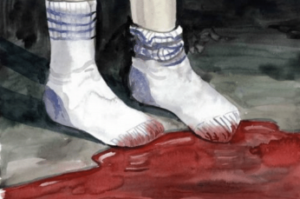 Who Put Bella in the Wych Elm?
Who Put Bella in the Wych Elm?
Mirit Skeen, School of Music, Theatre & Dance
Collaborator: Emerson Mae Smith, School of Music, Theatre & Dance
While WHO PUT BELLA IN THE WYCH ELM is part of the Basement Arts winter 2022 season, the goal of this project is to connect trans and GNCstudents across the entire U-M campus. This is a story about queerness, transness, climate crises, grief, and intergenerational trauma. It’s a show that may be a bit magical and gore-filled at moments but has a story that pivots around a transmasc nonbinary person’s transition. We’ve already begun working with other organizations outside of SMTD, including the Trans and GNC Art Review publications (TAGAR), and have organized an event in collaboration with them to reach out to more trans and GNC students on campus. We are also reaching out to the Spectrum Center and hope to include QR codes for donating to mutual aid funds for trans folks in the area and other trans fundraising organizations, including possibly Stand With Trans, Transgender Michigan, and The GenderGP Fund.
This play is being produced by Basement Arts and will take place March 24th and 25th, at 7pm and 11pm each night. We have an entire team of queer and GNC artists working on the show, including a lighting designer, scenic designer, practical effects artist, and sound designer to bring our overall immersive horror experience to fruition.
WHO PUT BELLA IN THE WYCH ELM? explores ideas of transness, inter-generational struggle, climate crisis, horror, queer friendship, and identity. Not only is it a story that features a nonbinary transmasc protagonist, but the majority of its creative team is made up of trans creators, something that the majority of us may never experience again. This is also the first living trans playwright that Basement Arts has ever produced, and probably one of the few to ever be produced on Michigan’s campus.
We want to create a bone-chilling experience that not only explores the complex themes of gender identity and transness, climate crisis, and queer friendship but also leaves audience members a little terrified to walk home alone at night. Furthermore, we want to use this story focusing on a nonbinary person and their transition and this team of trans artists and creators to connect queer and GNC students all across campus. There are few times students like myself could see themselves onstage in an honest representation, as someone whose identity is vital to themselves and their story but not the only piece of their story. We hope to use this show to allow so many other students on the U-M campus see themselves in this bizarre, strange horror piece.
 Who Put Bella in the Wych Elm?
Who Put Bella in the Wych Elm? Who Put Bella in the Wych Elm?
Who Put Bella in the Wych Elm?